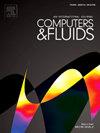A hybrid diffuse boundary approach for modeling contact-line dynamics within the framework of phase-field lattice Boltzmann method
IF 2.5
3区 工程技术
Q3 COMPUTER SCIENCE, INTERDISCIPLINARY APPLICATIONS
引用次数: 0
Abstract
Modeling the dynamics of the contact line among liquid, gas, and solid phases requires enforcing three fundamental boundary conditions on the solid surface: non-penetration, no-slip, and wetting. This study presents a hybrid diffuse boundary approach within the phase-field lattice Boltzmann method to effectively model contact-line dynamics. The proposed method integrates the diffuse domain approach into the Cahn-Hilliard equation to impose the wetting boundary condition, while the smoothed profile method is incorporated into the Navier–Stokes equation to enforce the no-slip and non-penetration conditions. By leveraging the diffuse nature of the boundary/interface, this approach naturally embeds all three boundary conditions directly into the governing equations, eliminating the need for complex numerical treatments at solid boundaries. Compared to the conventional sharp boundary method and the immersed boundary method, the hybrid approach significantly simplifies boundary condition implementation, particularly for complex geometries and moving solid boundaries. Validation tests confirm the accuracy of the method in reproducing prescribed contact angles and ensuring mass conservation. Furthermore, the approach is applied to simulate bubble migration through a pore throat, demonstrating a linear relationship between the Bond number and the contact angle, which delineates distinct passing and trapping behaviors.
相场晶格玻尔兹曼法框架下接触线动力学建模的混合扩散边界方法
模拟液体、气体和固相之间接触线的动力学需要在固体表面强制执行三个基本边界条件:非渗透、无滑移和润湿。本文在相场晶格玻尔兹曼方法中提出了一种混合扩散边界方法来有效地模拟接触线动力学。该方法将扩散域法引入Cahn-Hilliard方程以施加润湿边界条件,将光滑剖面法引入Navier-Stokes方程以施加无滑移和无穿透条件。通过利用边界/界面的扩散特性,这种方法自然地将所有三个边界条件直接嵌入到控制方程中,从而消除了在实体边界进行复杂数值处理的需要。与传统的锐边界法和浸入边界法相比,混合方法显著简化了边界条件的实现,特别是对于复杂几何形状和移动实体边界。验证试验证实了该方法在再现规定接触角和确保质量守恒方面的准确性。此外,将该方法应用于模拟气泡通过孔喉的迁移,证明了键数与接触角之间的线性关系,这描绘了不同的传递和捕获行为。
本文章由计算机程序翻译,如有差异,请以英文原文为准。
求助全文
约1分钟内获得全文
求助全文
来源期刊

Computers & Fluids
物理-计算机:跨学科应用
CiteScore
5.30
自引率
7.10%
发文量
242
审稿时长
10.8 months
期刊介绍:
Computers & Fluids is multidisciplinary. The term ''fluid'' is interpreted in the broadest sense. Hydro- and aerodynamics, high-speed and physical gas dynamics, turbulence and flow stability, multiphase flow, rheology, tribology and fluid-structure interaction are all of interest, provided that computer technique plays a significant role in the associated studies or design methodology.
 求助内容:
求助内容: 应助结果提醒方式:
应助结果提醒方式:


